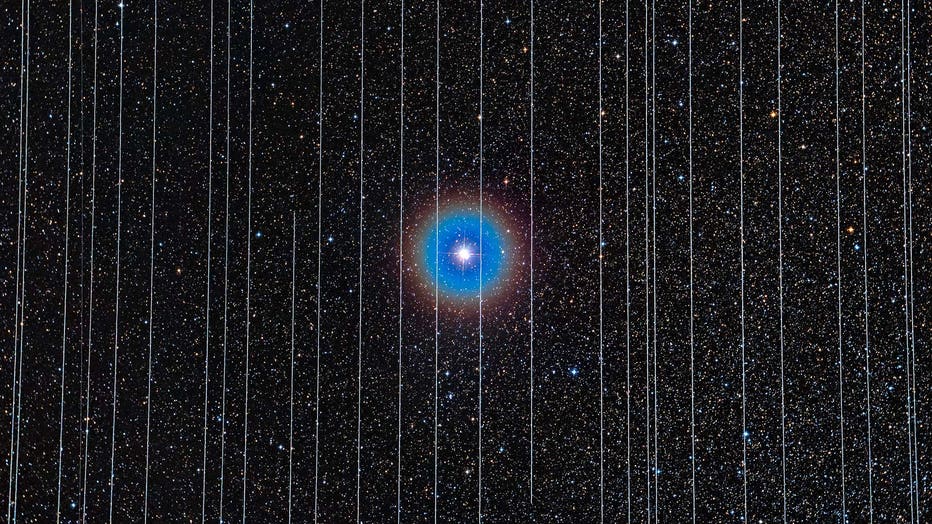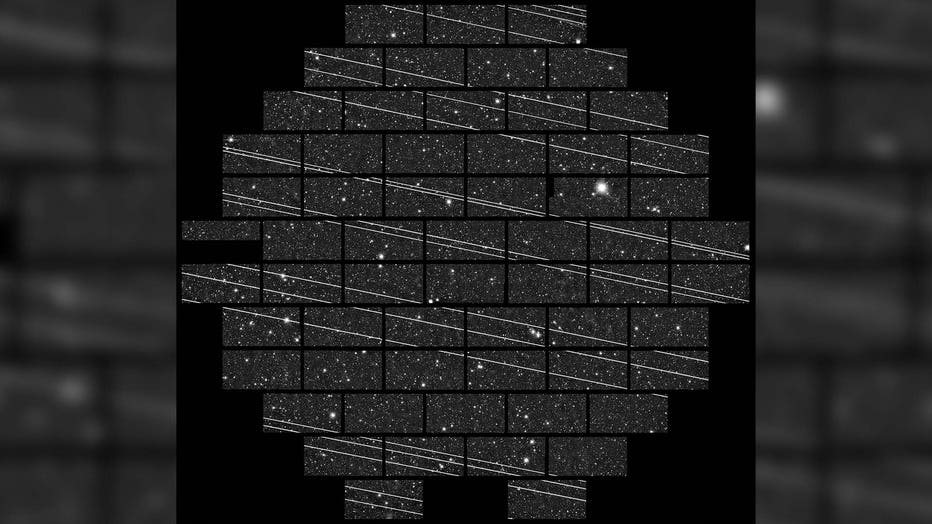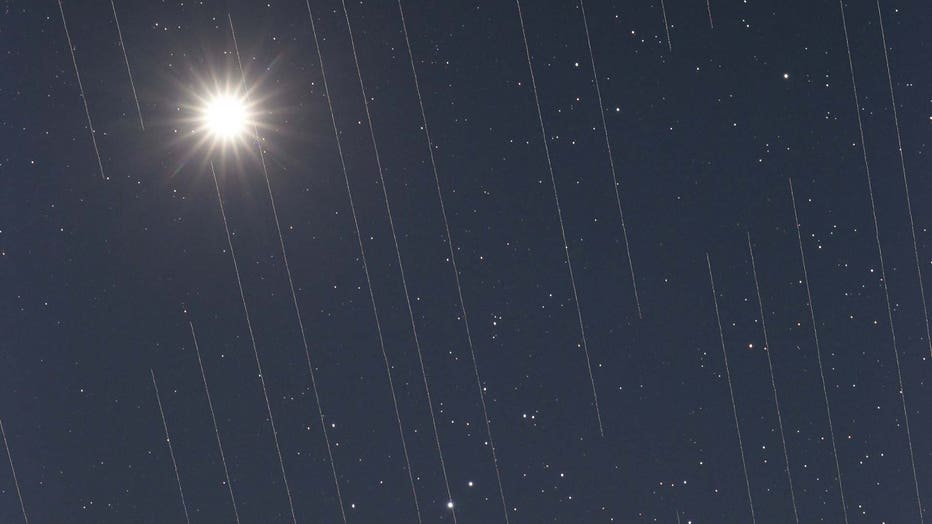Thousands of satellites, space junk surround Earth and it’s a problem, astronomers say

There's too many satellites, space junk around Earth
Astronomers are raising the alarm on the number of satellites orbiting Earth and say if nothing is done to regulate how many get launched in the future, it could be detrimental for not just the environment on Earth, but space as well.
Astronomers are raising the alarm on the number of satellites orbiting Earth and say if nothing is done to regulate how many get launched in the future, it could be detrimental for not just the environment on Earth, but space as well.
There are thousands of satellites currently orbiting the planet and there are a couple thousand more that are inactive and are slowly making their way back down.
Starlink, which is part of SpaceX, has the most in orbit, according to Science.org. The company has launched more than 1,700 satellites so far and it plans to send tens of thousands more into space in the future.
On top of the satellites mucking up the night sky for astronomers, millions of tiny pieces of reflective debris from various collisions are making looking for important celestial bodies even harder.
"For the most part, I think almost all observatories around the world will be affected to some degree. Some less than others," said Connie Walker, a scientist for the NSF’s National Optical-Infrared Astronomy Research Laboratory.

The background image shows the double star Albireo in Cygnus and was taken on Dec. 26, 2019. Two out of ten 2.5-minute exposures recorded Starlink satellites moving across the field.
RELATED: NASA launches satellite that will track Earth’s ‘health’
Astronomers across the world started more seriously raising the alarm on the vast amount of satellites and space junk orbiting the planet in May 2019 when Starlink launched its first 60 satellites into space.
"Astronomers went, ‘Ah! Oh my gosh!’ We didn’t know this was happening," Walker said with a chuckle. "Of course, SpaceX didn’t keep it a secret but it wasn’t really advertised to the level that astronomers picked up on."
But satellites have been a constant nuisance for astronomers even before SpaceX’s massive launch.
Depending on where you are in the world, an astronomer may see a couple hundred satellites pass across their viewing area, according to Walker.
"For me, during the whole night, probably a thousand satellites go across but you don’t see a lot of them. They have to be pretty much lit by the sun during the twilight hours and that could range up to a good fraction of the night depending on what time of year it is. For instance, if it’s the summertime, it’s (night) shorter, so you have more twilight higher in latitude and due to that, you’re not in Earth’s shadow so they do get seen," Walker said.
RELATED: Vice President Kamala Harris to convene 1st National Space Council meeting Dec. 1
Images taken from telescopes around the world often capture the "tracks" or "trails" of the passing satellites and will create lines, basically rendering images unusable for scientific purposes.
"You see a pinpoint going across the sky with your eye, but when you open a camera onto the sky it becomes a trail. And not only does it become a trail, but that trail can have significant consequences on the image," according to Walker.

Observations with DECam on the Blanco 4-meter telescope at the Cerro Tololo Inter-American Observatory (CTIO), a Program of NSF's NOIRLab, astronomers Clara Martínez-Vázquez and Cliff Johnson noticed something interesting. One of their images, the 33 (CTIO/NOIRLab/NSF/AURA/DECam DELVE Survey)
And while the issue doesn’t seem like much now, Walker believes the lack of regulation in regards to space and how humans use it could prove problematic in the future.
"It is a business. The companies are a business, they’re trying to make money but they also have a goal in mind too and whether you believe it or not, one goal is to bring broadband internet to the world. Like, we’re Zooming right now, because it’s going through a satellite and I’m able to talk with you and we’re hundreds of miles apart. That’s pretty amazing," Walker said.
"But, it’s like plastics. Plastics were like the best thing since sliced bread and we just went ahead and we mass-produced all this stuff from plastics for various reasons, whether they were bottles or whatever they were, even medical equipment. It was the coolest thing on Earth. But disposing them, no one thought that through and it’s not biodegradable. We’re harming our environment, we’re harming our space environment now and it’s harming people on Earth in various ways," Walker said.
RELATED: Russia rejects blame for space debris endangering 7 astronauts aboard ISS
Walker believes that while the goal appears noble, not everyone is thinking of the potential negative consequences that could emerge from hurling hundreds of thousands of satellites into the sky.
Rwanda hopes to launch more than 330,000 satellites into space in the decades to come in order to increase the nation’s access to the internet, according to Walker.
She said Rwanda’s request, which was made to the International Telecommunications Union in October, is daunting considering how many satellites are already floating around our planet.
"But still, it’s alarming to have that many up there. That’s much, much more than we have totally right now but, that said, when you look at all of the other companies like Amazon with their corporate project and One Web, based in the U.K., you’ve got to be well up into the tens of thousands by the end of the decade and over 100,000 with all the other companies included," Walker continued.
And the goal to provide internet to everyone on the planet is not the only motivator to launch more satellites.
RELATED: Longest partial lunar eclipse for 1,000 years to dazzle skywatchers on Nov. 19
In late September, NASA launched the Landsat 9 satellite into space which aims to track the "health" of the planet.
"The Landsat mission is like no other," said Karen St. Germain, director of the Earth Science Division at NASA Headquarters in Washington. "For nearly 50 years, Landsat satellites observed our home planet, providing an unparalleled record of how its surface has changed over timescales from days to decades. Through this partnership with USGS, we’ve been able to provide continuous and timely data for users ranging from farmers to resource managers and scientists. This data can help us understand, predict, and plan for the future in a changing climate."
Meanwhile, on Nov. 5, Vice President Kamala Harris announced that she, along with other leaders of the Biden administration, will hold an inaugural National Space Council meeting on Dec. 1.
"At that meeting, we will outline a comprehensive framework for our nation's space priorities. From our civilian efforts like those we have seen today to our military and national security efforts to STEM education and emerging space economy and what is abundantly clear is that when it comes to our space activity, there is limitless potential," Harris said during a visit to NASA's Goddard Space Center.
Harris also highlighted the work being done by Landsat 9 which joined its sister satellite, Landsat 8, and the pair work in tandem to "collect images spanning the entire planet every eight days," according to NASA.
RELATED: NASA: Asteroid the size of Empire State Building to whiz close by Earth in coming days
With more satellites come more chances for collisions, and with more collisions comes more debris — making it hard for astronomers to accurately see what’s going on in the space around Earth and beyond.
The millions of pieces of tiny space debris can actually add to the light pollution already plaguing the planet. "And raise the levels of how bright the night sky is so for people and animals, and whomever that depend on the night sky, that can be a factor," Walker said.
"Astronomers really are going to lose the twilight hours, I think. They do their best research on near-Earth asteroids at that time because it’s the time of night you can see asteroids better. Those kind of hours will be brightened significantly," Walker said.

This image of Venus and the Pleiades also shows the tracks of the Starlink satellites. These satellites which are located at an altitude of approximately 550 kilometers, are part of an ever-growing constellation of satellites aimed to provide worldwi (Torsten Hansen/IAU OAE via the International Astronomical Union )
"So, it’s starting to get alarming because safety is a big issue up there and collisions can produce a lot of problems in terms of safety in other things," Walker said.
On Monday, a Russian weapons test created more than 1,500 pieces of space junk now threatening the seven astronauts aboard the International Space Station, according to U.S. officials who called the strike reckless and irresponsible.
RELATED: Liftoff! SpaceX launches batch of Starlink satellites into orbit
The State Department confirmed that the debris was from an old Russian satellite destroyed by the missile.
"Needless to say, I’m outraged. This is unconscionable," NASA Administrator Bill Nelson told the Associated Press. "It’s unbelievable that the Russian government would do this test and threaten not only international astronauts, but their own cosmonauts that are on board the station" as well as the three people on China's space station.
Nelson said the astronauts now face four times greater risk than normal. And that's based on debris big enough to track, with hundreds of thousands of smaller pieces going undetected — "any one of which can do enormous damage if it hits in the right place."
According to Walker, Russia’s alleged actions were highly dangerous, but there was no one around to tell them they couldn’t do it — and that is the problem.
"At this point in time, there’s no one really out there that can say, ‘You can’t do that.’" Walker said. "They needed target practice, I guess, but it should have gone through some proper channels. But what are those proper channels?"
RELATED: Eiffel Tower-sized asteroid to fly past Earth next month
Until there is a governing body that can reprimand and "police" space, Walker said the next best thing astronomers have is communicating with companies and countries directly.
"We’re actually working with companies, which is the best thing of all. To be able to work with the companies, and there’s three companies that we’re working with right now and we’re trying to add to that list and they’re being pretty amenable about working with us. Although they can’t always promise changes, and I can totally understand that," Walker said.
"We started communicating every single month for about a year with SpaceX, which was wonderful. And it was through the relationships they had with the Ruben Observatory that some solutions were actually made," Walker continued.
The Ruben Observatory, which is located in Chile, is expected to start operating within the next year and aims to observe and study dark energy and dark matter, take an inventory of the solar system, explore the transient optical sky and map the Milky Way, according to the observatory’s website.
"They first darkened one or two of the satellites and then tried more," Walker said. SpaceX then put visors on their satellites to prevent certain parts from reflecting too much sunlight. While the effort proved effective, science and technology are continuing to evolve at a rapid pace and SpaceX’s once-lauded solutions are now not having the same impacts as they once were.
RELATED: NASA targeting February for launch of first moon rocket since Apollo mission
"Now they want to have these inter-satellite communications with lasers so they’re going to have to take away the visors. So that was a solution that brought us almost up to the point where we could say, ‘Alright, we’ll still have main street, we’ll get rid of the residual effects that you see on the image,’ but now it’s like two steps backwards," Walker continued.
Despite that setback, Walker said companies are trying to find solutions. Companies such as Amazon and One Web have approached the astronomical society to find a happy middle for both businesses and scientists.
"There’s so many things to think about and readjust," Walker said. "But then you also look at, can these things actually be done?"
The goal for both companies and astronomers is to determine the most reasonable solution that won’t break the bank.
Could there be a type of software that will eliminate any unwanted images from telescopes? Could there be someone whose sole job is to actively avoid catching satellites on telescopes? Or could companies possibly launch their satellites out of the line of sight of observatories? The answers to all of these questions is "not totally," according to Walker.
RELATED: NASA says next astronaut moon landing will be in 2025 at earliest
"The question, too, is: Are we going to be funded?" Walker said.
Walker said funding is already scarce in the realm of astronomy, so, adding another financial hurdle — like how to efficiently move satellites from scientists’ line of sight — is making things tighter than they are already are.
"The happy middle is that they (companies) have to really have a stringent plan for how many can launch, how many can be up there, what their deorbit time is because they can build in when they have to deorbit," according to Walker.
"No one’s going to go up there and bring the satellites down, it’s just too expensive. And the deorbit, the higher you go, the longer it takes to deorbit. So, it could take 100 years for something that’s a thousand kilometers up there. It could take five years for something that’s maybe at 600 or less kilometers if you build it in, but usually it’s something around 25 years. Satellites stay up there longer than their usefulness, basically. Because, they get used for five years then they’re antiquated," Walker said.
When putting a satellite into deorbit, Walker said, companies must consider the size and materials because once the satellite comes hurtling back through Earth‘s atmosphere, depending on the materials used, it could either burn up or crash into a populated area and hurt people.
RELATED: Leonid meteor shower 2021: When it will peak, where to best see it
"They (companies) have to go beyond what they have now and have a solid plan for deorbiting," Walker said.
Walker said apart from having a solid and safe plan to get useless satellites out of the sky, a broader dialogue about the issue needs to be initiated.
"We need a stronger relationship with the different companies and to work with them even more closely," she added.
Walker said there are some who believe there should be an absolute halt to any more satellite launches in the future, and while Walker acknowledges that’s not possible, she said there needs to be accountability. Those who are launching satellites need to do their due diligence to ensure they’re doing everything they can to deflect any negative impacts satellites and space trash have.
"And in some ways, that’s not unreasonable. You want to think things through. It’s not like we don’t want it to happen, we just want to think things through and come up with solutions before we make it worse, as we should have done with plastics," Walker said.
"This is our only spaceship," Walker said. "We have to be good stewards otherwise we’ll create irreparable problems. Better start now."
The Associated Press contributed to this report. This story was reported out of Los Angeles.

